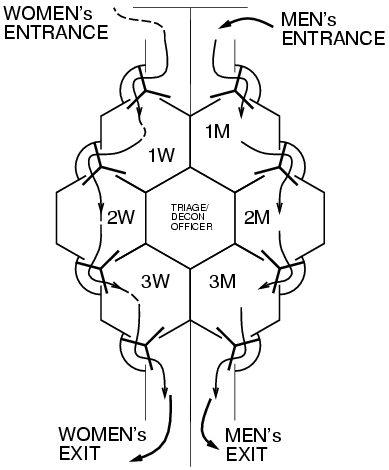
where 1W, 2W, and 3W denote the three stages (1, strip; 2, wash; and 3, cover, respectively) of the Women's pipeline, and likewise 1M, 2M, and 3M for the Men's pipeline.
Using a unique hexagonal architecture, a close-packing of rooms is achieved. Moreover, the 120 degree angles where room edges meet facilitates the use of turnstiles to ensure a one-way flow of persons through the facility.
A first group of six persons enters through a first turnstile into a hexagonal shaped clothing bagging room where each person must remove all clothing, and cannot leave the bagging area until being completely free of clothing, jewellery, personal effects, or other materials that could interfere with complete decon or could harbour contamination or chemical agents.
A second remotely unlocked turnstile allows these persons to enter into a hexagonal shaped shower room for decontamination with an appropriate decon solution. A third remotely unlocked turnstile with Chemical Agent Monitor (CAM) prevents persons from leaving the shower room until they are free of contaminants.
Persons then enter an examination/vaccination room.
These three hexagonal rooms (stripdown, washdown, examination) are replicated: three rooms for men, and another three rooms for women. The hexagonal packing of these six rooms optimizes space usage, and also ensures high throughput since no corner turns more than 120 degrees. Moreover, all six rooms are built around a seventh triage observation area, for triage staff or remote video monitoring equipment. The remote observation facilitates telemedicine as well as the remote operation of passage locks and plumbing valve controls.
Makeshift facilities such as decon tents, or temporary setups of fire departments using covered decon lanes, or Ladder pipe Decon System (LDS) fail to make optimal tradeoff between privacy and throughput, and fail to provide adequate security (prevention of panic-stricken victims from fleeing from the scene, protection of victims from prying eyes of television news crews, etc.).
Although some facilities are built into hospitals, these facilities are lacking in many design characteristics.
This paper describes a new kind of facility that could be installed into the central emergency receiving room of hospitals, the central customs and immigration area of airports, and other plenary areas of large facilities throughout the country.
Without pipelining, it typically takes each victim 30 seconds to strip, 30 seconds to wash, and 30 seconds to cover = 90 seconds total = 40 persons/hour throughput.
This assumes the three steps:
However, by having stages, where victims move through a decontamination line, with pipelining, it is possible then to decontaminate persons at a rate of 30 seconds/person = 120 persons/hour throughput. It still takes 90 seconds to process each person, but in steady state conditions, persons enter the decon line every 30 seconds, and persons emerge every 30 seconds, so the THROUGHPUT is three times as much.
With parallelism in addition to pipelining, a further increase can be obtained. Suppose, for example, that each stage of the pipeline can accomodate six persons at a time (e.g. a six station stripdown room, six station shower, and six station examination/drying/dressing room).
If privacy were not a problem, the throughput could be increased to 720persons/hour.
However, when six persons enter the stripdown room, shower room, and drying room, together, there is a privacy problem. This problem was solved by having separate decon pipelines for men and women, so that the facility could process 720men/hour and 720women/hour. In addition to solving the privacy problem, having these two separate pipelines resulted in additional parallelism: 720men/hour+720women/hour=1440 persons/hour.
(Follow this link for more details on the two processor three-stage 6-channel pipeline for processing 1440 persons per hour.)
The final design is depicted below:

where 1W, 2W, and 3W denote the three stages
(1, strip; 2, wash; and 3, cover, respectively) of the Women's pipeline,
and likewise 1M, 2M, and 3M for the Men's pipeline.
To see how this floorplan fits into the 80 Spadina Avenue space,
follow this link:
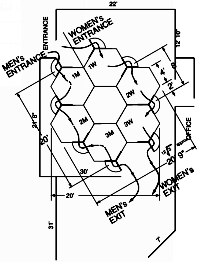
A feature of this space-efficient hexagonal packing is that people never need to turn at angles tighter than 120 degrees, so throughput is very high. Also, the 120 degree angles where walls meet facilitates the installation of high security rotogate turnstiles like those used in unguarded automated subway exits. This ensures that no person can flee from the facility without passing through in the proper direction. Moreover, the hexagonal packing of the six rooms creates lost space in the center. This lost space is actually put to good use as a central triage observation room. The walls of this central room are made entirely of smoked lexan so that medical staff in the room can have a clear view of the decontamination procedure taking place in the six rooms around the outside, but, for reasons of security, and to protect the privacy of the victims, persons in the six rooms cannot see into the central triage room. This central triage/observation room also houses computers with telemedicine videoconferencing capability so that remote medical staff can ensure that safety procedures are complied with.
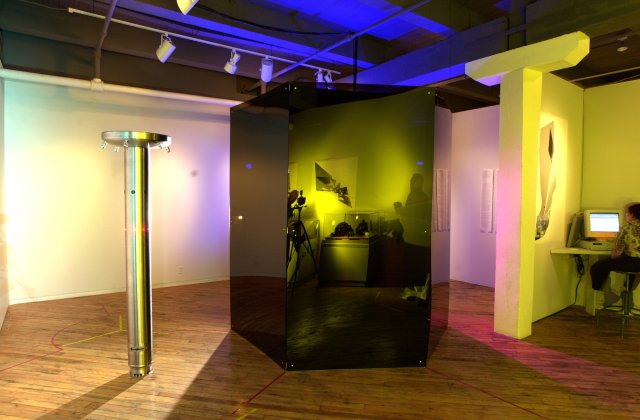

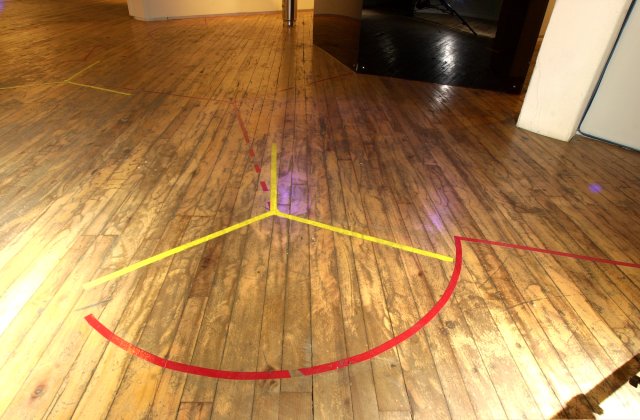
Separate entrances for men and women are to be provided. Three of the six rooms are for men, and the other three are for women.
A Bradley column shower is to be installed in each of the two shower rooms.
A Bradley six person
column shower donated by Bradley Corporation
has already been installed in the hexagonal-shaped men's washdown room:
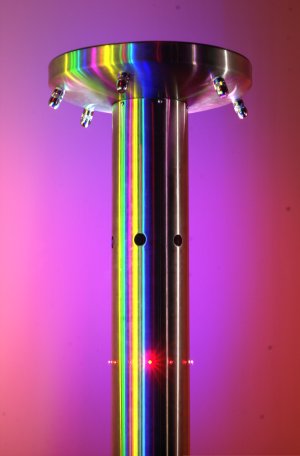
The knobs and soap dishes have been removed from the column shower,
and the holes where these items once were have been replaced with a
machine vision system comprised of 12 laser diode scanners together
with six round lexan viewing windows moulded into the inside of the
column. There are two laser diode scanners for each of the
infrared sensors that are located at each of the six stations.
The system is sealed and completely watertight. Here is a closeup
picture of the six round watertight
infrared openings
of the column shower currently in use in the men's washdown room:
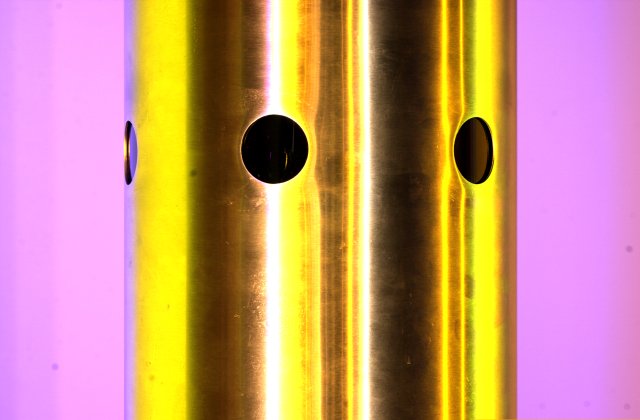
Three of the round smoked lexan sensor openings are visible here.
Up to six men can use this shower at the same time, but only the
number of stations actually being occupied will consume water.
Moreover, water is only consumed when a user is present.
Since there are no knobs or controls of any kind, there is no possibility
for deliberately destructive acts such as might otherwise happen
when users deliberately
(or accidentally) leave the water running.
Moreover, in a state of anthrax panic, victims need not concern themselves
with which way to turn a knob to operate the device.
Finally, a central computer monitors the exact amount of water usage,
so that the amount of decon solution needed, as well as the amount of
waste water runoff that must be contained, can both be calculated.
Each of the six nozzles face one side of the hexagonal shaped shower
room to maximize space usage and efficiency.
Body scan automates issue of replacement clothing/uniforms, etc.
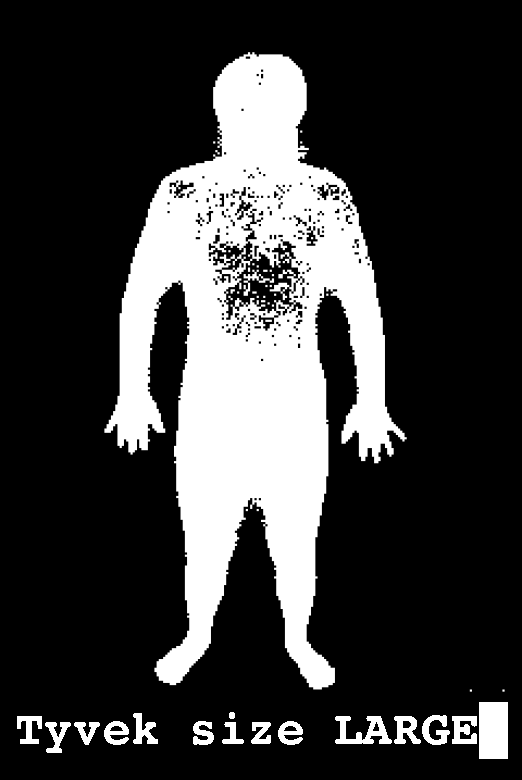
Typically, however, the medical personnel, triage staff,
or decontamination officers
operate the facility remotely by way of six videoconferencing systems
installed in the
triage/observation room. The six
television receivers at a remote location for use by medical
personnel, triage staff, or decontamination officers, are shown below:
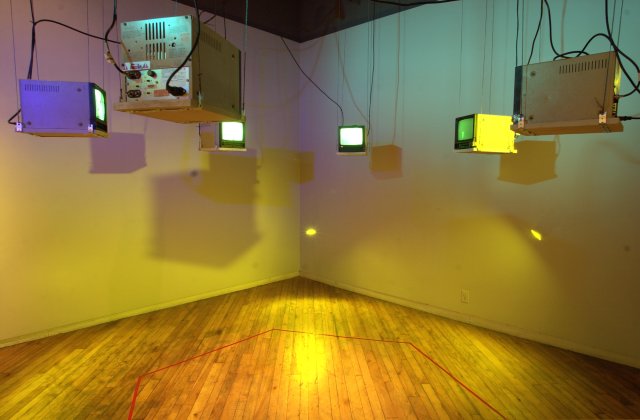
The six television receivers are arranged in the same hexagonal formation.
Six closed circuit television receivers suspended from the ceiling display outputs from each of the six decontamination rooms, as observed from the triage room.
Note also the hexagon made from red tape on the floor has the same physical dimensions as the triage/observation room. The display surface of each of the six television receivers is aligned with and centered along the middle of a corresponding side of the hexagon depicted on the floor in red tape.
Although the television displays shown here are of poor resolution:



(Here is the view from the men's decontamination/triage officer station,
during a Decon Drill, held at the 80 Spadina Ave. facility,
Thursday July 5th, 2001.)
The telemedicine video links are of very high quality and high resolution,
so that remote
triage personnel can clearly distinguish, for example, anthrax,
from dust or other dirt. Archived images can also be used as evidence
in criminal investigations.
Thus high resolution sensors are to be used throughout the facility to ensure satisfactory video quality.
Here is a view of the three rooms on the men's side, as seen, from the top level of the male decontimantion officer's station, where these three easy steps are visible:
From the central hexagonal shaped triage/observation room, decontamination officers can view out through the smoked lexan walls, into each of the six hexagonal shaped rooms.
The above view illustrate the: (1) Strip; (2) Wash; and (3) Cover procedure.
These three steps that were practiced in the 2001 July 5th decon drill are visible on the above control panel:
It may be noted that in a real terrorist attack:
Download a Decon Drill training video.
See also, the final chapter in Cyborg: Digital Destiny and Human Possibility in the Age of the Wearable Computer